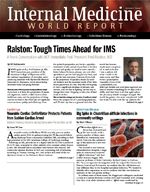Norovirus not trivial illness in older patients
Norovirus not trivial illness in older patients
Patients and practitioners have underestimated novovirus, which is associated with morbidity in the elderly
By Kurt Ullman
Norovirus gastroenteritis is usually seen as minor illness confined to cruise ships and day care centers. But a recently completed population-based study from the Netherlands suggests otherwise, especially in older groups.
“While norovirus gastroenteritis is generally viewed as a trivial illness of short duration, this study using population-based databases, shows its overall public health consequences have been underestimated,” said Liselotte van Asten, from the Center for Infectious Disease Control in The Netherlands. “Extreme outbreak activity due to the introduction of new strains coincided with sharp increases of unspecified gastroenteritis morbidity, hospitalizations and even deaths in the total Dutch elderly population.”
The researchers looked at trends of gastroenteritis with unspecified cause in visits to general practitioners, hospitalization, and deaths. They also looked at their association with known temporal trends in norovirus outbreaks in the 2002/2003, 2004/2005, and 2005/2006 winter seasons. Information on outbreaks, clinic attendance, hospitalizations, mortality was obtained from various national databases. Using weekly counts of GI complaints or diagnoses from local registries in those 65 years and older, they applied Poisson regression analyses adjusted for additional pathogens and seasonal trends.
In the target population, each norovirus outbreak was associated with an estimated 26 visits to a GP (95% confidence interval [CI]= 17-34), 2.2 hospitalizations (95% CI 1.6-2.7) and 0.14 deaths (95% CI 0.08-0.21) for unspecified gastroenteritis. For the worst norovirus season (2004-2005), these models attributed 3804 GP visits, 318 hospitalizations and 21 deaths to unspecified gastroenteritis diagnoses. Peaks in mortality did not coincide with known seasons for influenza or other common diseases. This was among an elderly population of 2.3 million.
“To our knowledge there is no other published data that estimates the impact of norovirus outbreaks at different public health levels: from milder illness (presenting to general practitioners), to severe illness (presenting at or during hospitalizations), and even deaths,” said Dr. van Asten. “That norovirus is significantly associated not only with morbidity but even with deaths in the elderly is remarkable considering that norovirus is regarded as an illness with a low case-fatality rate.”
Dr. van Asten did stress that their results were not based on individuals followed up from symptoms-to illness-to death, but rather were statistical associations at the population level. Since illnesses and death from gastroenteritis are poorly recognized and reported, it is possible that their results may actually underestimate the real situation.
“The results however are still important for health practitioners as heightened alertness may help patients in whom the gastroenteritis symptoms may otherwise be regarded as trivial,” she said. “The numbers are substantial and warrant further investigation. Further research should also investigate to what extent the prevention of norovirus infection improves longevity in the elderly—either by hygiene and isolation measures or by treatment.”
Source:Van Asten L, et al. Unspecified gastroenteritis illness and deaths in the elderly associated with norovirus epidemics. Epidemiology. 2011;22:336-343.
